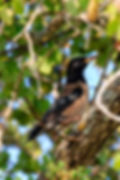Mannar again and the road to Jaffna
- Nirmal Kumarasiri
- Feb 10, 2019
- 4 min read
Updated: May 2
A novice’ s log of journey to beautiful #Mannar again and beyond. #birdsofsrilanka

For someone serious about birds in Sri Lanka, Mannar is a destination you will visit again and again. My first trip to this beautiful place was covered in 'The Extraordinary Mannar' post. The road from Mannar to Jaffna through Pooneryn is a must-visit as it goes through flat, arid but rich birding sites. It's a beautiful drive. This blog post is about that super adventure.

If you leave Colombo at 2:00 AM, reaching Medawachiya takes just about 2.5 to 3 hours thanks to smooth, well-marked roads and minimal traffic at that hour. However, the journey from Medawachiya to Mannar calls for a more cautious approach. While the road conditions remain good, the route passes through dense jungle stretches with few signs of human habitation. The primary hazard on this leg of the trip is cattle wandering onto the road, but it’s not uncommon to encounter wild animals as well. For everyone’s safety—yours and the animals’—it’s best to reduce your speed to around 50 km/h for the 84-kilometre stretch to Mannar. Still, with an early enough departure, you can expect to arrive just as the first light breaks over the horizon. And if you’ve timed your visit right, what awaits you in Mannar is nothing short of breathtaking.
Hundreds of Greater Flamingos have descended upon the salt flats of Mannar, creating a rare and spectacular sight that doesn’t occur every year. While their arrival isn’t guaranteed or consistent, Mannar remains one of the few places in Sri Lanka where these elegant birds tend to gather between December and March. Remarkably, this year, Mannar is the only location where they have chosen to appear, making the spectacle even more special for those fortunate enough to witness it.

This particular morning, the light was not great due to gloomy conditions. Still, what a great experience of colours, sounds and behaviour.

As usual #Vankalai has rejuvenated it self after rains and the marshes are hosting large flocks of water birds. Although some of the duck species were not to be seen, the marshes are busy as usual with the migrants and the residents.
Among the migrants, this year the Glossy Ibis have come down in numbers.
The second day of my stay in Mannar was devoted to exploring two key birding hotspots that every enthusiast should visit while in the region. One of them is the Giants Tank Sanctuary—a hidden gem nestled about 30 minutes from Mannar. This lush jungle paradise encircles the ancient reservoir known as the Giant’s Tank and offers a rich, unspoiled habitat for a variety of bird species. However, unlike popular national parks, this sanctuary remains largely off the beaten path. Navigating its maze of narrow, unmarked roads can be challenging, so having a sturdy 4x4 vehicle that you’re not afraid to put through its paces is essential for venturing deep into the wilderness.


This year, large flocks of Rosy Starlings have come down to the north west. There were many flocks inside the jungle patches having a feeding frenzy.
As evening approaches, these boisterous visitors gather in their thousands, forming vast flocks that fill the sky in a breathtaking aerial dance just before sunset. But before this mesmerizing display begins, they indulge in a quick, spirited bath—an essential ritual to freshen up before the grand performance.
One can find many other birds and unique flora within the Giants Tank sanctuary.
Another unforgettable spectacle I encountered was the mass emergence of millions of butterflies streaming out of the jungle. These delicate white butterflies formed flowing columns along the narrow forest trails, gradually merging into a continuous, almost surreal river of fluttering wings. I had no idea where they were headed, but watching them move in such unison was nothing short of magical—a moment of quiet wonder in the heart of the wild.
That same evening, I made my way toward Jaffna, and the landscape that unfolded before me was both beautiful and uniquely captivating. Vast, flat plains stretched endlessly toward the horizon, bathed in golden light. Large herds of domestic cattle roamed freely across the open land, adding a serene, pastoral charm to the scene—it felt like stepping into a different world altogether.

For much of the road from Mannar to Pooneryn, the roadside trees have been cleared—likely a lasting consequence of the war, when vegetation was removed to prevent the concealment of roadside explosives. In the absence of trees, predators in search of a vantage point have adapted by perching on electric wires. Along this stretch, it's common to see raptors and other birds of prey surveying the vast plains below from their high perches, patiently watching for movement across the open land.
After driving all the way up to Sangupiddi causeway which connect Pooneryn to Jaffna, I decided to turn back and head back to Mannar.

As always, the sunset over the expansive lagoons near Mannar—particularly in Vidathalathivu—was nothing short of breathtaking. The sky burned with hues of gold and crimson as thousands of Rosy Starlings filled the air, flying in perfect synchrony. Their elegant formations danced against the fading light, a graceful ritual as they settled in for the night, basking in the last warm rays of the sun—a perfect end to the day.



The next day promised even more adventures with the prospect of exploring Jaffna for the first time.





























































